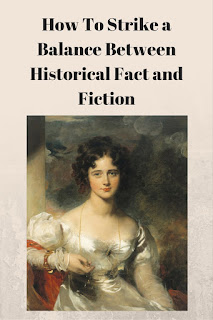I enjoy reading non-fiction history books, and I use a great deal of what I learn in my Regency and historical romance novels. I try to be as historically accurate with my writing as possible but sometimes it either isn't possible or I need to take some artistic license in order to move the story forward. So how do I, as a writer of over ten published historical romance novels and novellas, strike a balance between historical fact and either the needs of the story or the reader's expectations about history?
One way that I play with history and still remain true to it is by determining if something would have been possible during the time period I'm writing in. For example, I enjoy reading about medical history, and teach on-line classes about, and I often incorporate my research into my novels. In the time period that I write in (1800-1820), medicine was still rooted in the very distant past. However, there were many medical men making discoveries that were not picked up by the medical community either because the surgeon failed to publish his findings or the medical community wasn’t ready to accept them. By doing research which proves that something can be attributed to an earlier source, I can still be historically accurate while crafting my fictional story. The research also allows me to use the proper nomenclature which adds to the overall feeling of the time period.
 Another instance in which I remained true to history while still writing my story was with my novella Mask of the Gladiator. The story takes place at the end of Caligula's reign and, at that time, the famous Roman Colosseum had not yet been built. I couldn't write about a gladiator fighting in Rome without a colosseum. So how did I get around the problem? I did some research to see if there were colosseums in Rome at the time and there were. In the end, I simply wrote about a nameless colosseum instead of THE Colosseum. I stayed true to history and my story.
Another instance in which I remained true to history while still writing my story was with my novella Mask of the Gladiator. The story takes place at the end of Caligula's reign and, at that time, the famous Roman Colosseum had not yet been built. I couldn't write about a gladiator fighting in Rome without a colosseum. So how did I get around the problem? I did some research to see if there were colosseums in Rome at the time and there were. In the end, I simply wrote about a nameless colosseum instead of THE Colosseum. I stayed true to history and my story.
 Another instance in which I remained true to history while still writing my story was with my novella Mask of the Gladiator. The story takes place at the end of Caligula's reign and, at that time, the famous Roman Colosseum had not yet been built. I couldn't write about a gladiator fighting in Rome without a colosseum. So how did I get around the problem? I did some research to see if there were colosseums in Rome at the time and there were. In the end, I simply wrote about a nameless colosseum instead of THE Colosseum. I stayed true to history and my story.
Another instance in which I remained true to history while still writing my story was with my novella Mask of the Gladiator. The story takes place at the end of Caligula's reign and, at that time, the famous Roman Colosseum had not yet been built. I couldn't write about a gladiator fighting in Rome without a colosseum. So how did I get around the problem? I did some research to see if there were colosseums in Rome at the time and there were. In the end, I simply wrote about a nameless colosseum instead of THE Colosseum. I stayed true to history and my story.Sometimes, no matter how much research I do, I can't find what I need in the historical record. The story must go on, so I'm forced to invent something. One way to make historically inaccurate contrivances work is to give them the flavor of the era. Again, this is done with research. For example, having an understanding of the medical capabilities of the period can help me create a believable medical treatment. For example, Georgian and Regency people didn’t understand germ theory but they did have some experience with making the connection between cleanliness and a decrease in infection. The Royal Navy did this by regularly cleaning ships in order to keep down instances of ship fever. Anyone involved in the production of milk and cheese understood that the dairy house had to be very clean in order to keep the dairy products from spoiling (click on the cow above to see an article on it). I've used these connection in my novels in order to make it more believable when a character decides to clean a wound. I usually have the characters mention their reasons for their behavior with a single line or comment. The brief detail gives the characters the proper motivation and roots them in their historical time period.
I hope these tips, and my experiences, help you the next time you're struggling to strike a balance between fiction and history.
Please check out my books because I worked to strike a balance between historical fact and fiction in my stories.




2 comments:
Welcome to the blog hop.
Hello Georgie! Thanks for sharing.
Post a Comment